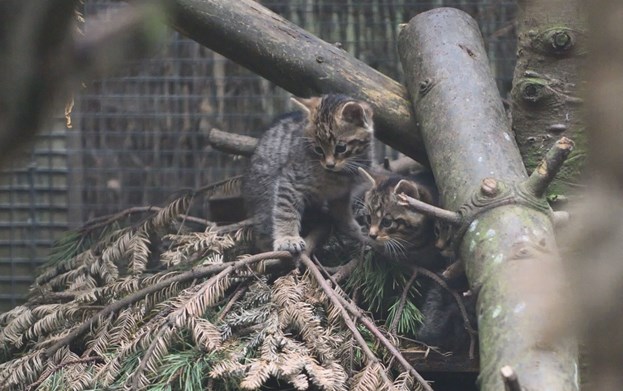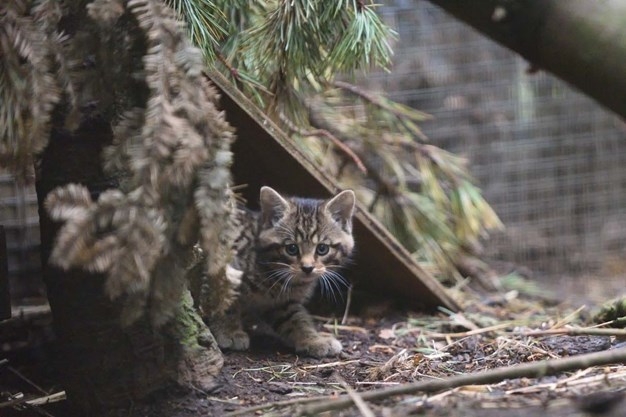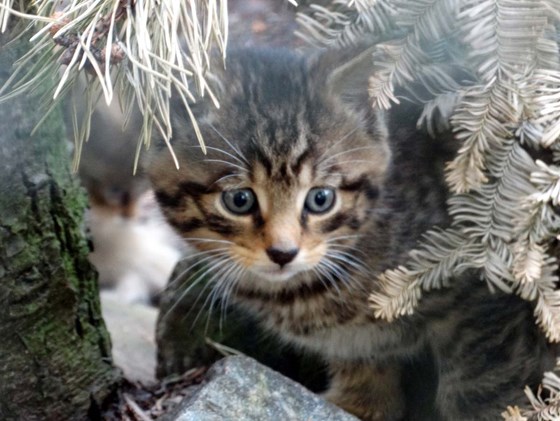Incredibly rare Scottish wildcat kittens born
13/07/2016 in Highland Wildlife Park

(Photo by Alex Riddell)
The Royal Zoological Society of Scotland (RZSS) is pleased to welcome not one but two litters of Scottish wildcat kittens at RZSS Highland Wildlife Park. These kittens will go on to play a vital role in the conservation of the species.
Also known as the ‘Highland Tiger’, this incredibly rare native species is facing the very real threat of extinction due to hybridisation with domestic and feral cats, habitat loss and accidental persecution. However, as a result of coordinated conservation efforts and a conservation breeding programme for eventual release, the species has a fighting chance of survival.
The kittens have spent the first couple of months safely tucked in their dens, but have been venturing out more over the last few days. The playful behaviour that park visitors will see between mother and offspring is not just important for their relationship but vital for the kittens to learn key behaviours.

(Photo by Alex Riddell)
David Barclay, RZSS Cat Conservation Project Officer said: “The birth of these rare kittens is not just another boost for the captive breeding programme but for the conservation of this magnificent native species as a whole. Through our work with Scottish Wildcat Action, we are doing everything we can to save the Scottish wildcat from extinction and the safety net of the captive breeding programme is becoming more and more vital as wild populations continue to decline.
“We have recently developed an off-show breeding facility for the wildcats, one of the largest of its kind in the world for small cats. Through the conservation breeding and pre-release training programme we will eventually use captive born wildcats to carry out reintroductions across Scotland.”
RZSS Highland Wildlife Park has a strong track record in breeding the Scottish wildcat, helping to maintain a healthy captive population and establishing a conservation breeding for release programme, which will be critical in securing the future of Scotland’s last remaining native cat species.
RZSS is a key partner in Scottish Wildcat Action, the first national project to save the highly endangered Scottish wildcat from extinction. Scottish Wildcat Action brings together more than 20 other organisations in the conservation, scientific and land management communities – supported by Scottish Government and the Heritage Lottery Fund – and represents the best chance the wildcat has of surviving in the long term.
RZSS is leading on the conservation breeding for release aspect of the project. This will be accomplished with the help of newly built off-show breeding enclosures for Scottish wildcats at RZSS Highland Wildlife Park. The pioneering breeding programme will see a combination of wildcats born in captivity and a select number of wild-caught cats housed in large, naturalistic enclosures, breeding to produce offspring for reintroductions. As the enclosures are off-show, it will ensure the cats do not become accustomed to people or traffic, thereby maintaining the natural behaviours necessary for their survival in the wild.

(Photo by Jan Morse)
Although some similarities with domestic tabby cats exist, the two species are not to be confused. The Scottish wildcat is a unique and isolated sub population of the wildcat that is found in continental Europe, which has been separated from them since the end of the last ice age over 9,000 years ago. Domestic cats originate from Near Eastern (African) wildcats and have been through a process of domestication. Wildcats prefer to live alone but will come together for a short period for breeding, normally giving birth to two or three kittens, which the mother will protect fiercely.
With their big, bushy, black-ringed tail and tenacious behaviour it is no surprise that the Scottish wildcat was used historically in many Highland clan crests. The Scottish wildcat is one of the rarest cat species in the world and is critically endangered in the wilds of Scotland. Thanks to Scottish Wildcat Action, the only national action plan for the species, the future looks brighter for this iconic species. The combination of in-situ conservation with landowner and local community engagement, plus a dedicated conservation breeding for release programme, is providing real hope for the future of the species.
…ends...
Featured Content
Featured Articles

An update from the Budongo Forest
19/04/2024 in Conservation

Edinburgh Zoo named best zoo in Scotland
15/04/2024 in Edinburgh Zoo

























Follow EZ